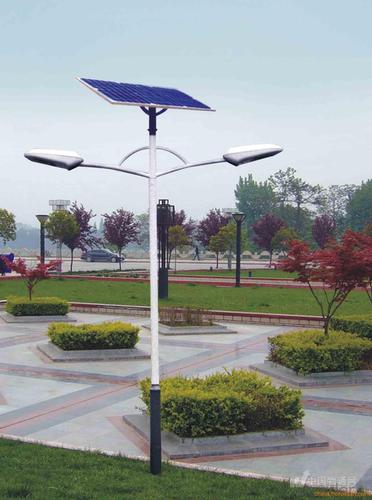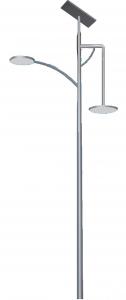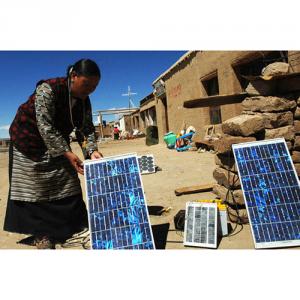Solar Light for Flagpole - Solar Street Lamps, Environmental Friendly, Cost Saving, 600
- Loading Port:
- Ningbo
- Payment Terms:
- TT OR LC
- Min Order Qty:
- 1 set
- Supply Capability:
- 5000 set/month
OKorder Service Pledge
OKorder Financial Service
You Might Also Like
Step 1 – Find area in need of street lights
The first thing to figure out is the length of road in need of street lights. This can be a small entrance road only a couple hundred of feet long to miles of streets through an area. Does the area currently have any type of lighting available? What is the reason for needing street lights in this area?
Step 2 – Find out if electric is available
Is the electrical grid already nearby or would you need to call in the power company to bring in electrical lines? If the electric needs to be brought to the area, how much is this going to cost? Depending on how far the grid electric is from the location of the needed lighting, this can be quite expensive.



Step 3 – Determine the lighting requirements
How much lighting is needed on the street? Do the lights need to be dark sky compliant? Do the street lights need to run from dusk to dawn or for only a specified number of hours at night? Are the street lights able to dim in the middle of the night and still provide enough lighting? These questions need to be answered before you can decide on how many lights you will need to complete the project.
Step 4 – Find all alternatives
Solar power street lights are an option to traditional electrical lights. Solar street lights do not need the electrical grid to be brought in as they are self-contained units that provide their own provide the best lighting solution by using lower amounts of power, better optics, dimming features where needed, and cost less in an overall solution.
Step 5 – Contact companies for quotes
The last step after gathering the above information is to contact companies for quotes. Just like with anything else, get multiple quotes and weigh the pros and cons of every company and situation. The lowest quote is not always the best, so make sure to do your research on companies and products before you submit a purchase order.
If you take your time, do your research, and gather needed requirements, your next street lighting project will be a success. Never be afraid to ask a lot questions, they may save you time and money in the long run.
- Q: Are solar lights suitable for historical or heritage sites?
- Depending on various factors, solar lights can be a viable option for historical or heritage sites. One of the main factors to consider is the preservation requirements of the site. Solar lights are typically non-intrusive and can be easily installed without causing any damage to the site's infrastructure or the surrounding environment. This is especially crucial for historical or heritage sites that prioritize preservation and conservation. Furthermore, solar lights offer the advantage of being independent from the electrical grid. This means that they can be installed in remote or hard-to-reach areas without the need for extensive electrical infrastructure. This can be particularly advantageous for historical or heritage sites located in rural or underdeveloped areas. In addition, solar lights are energy-efficient and environmentally friendly. They capture solar energy during the day and store it in batteries, which then power the lights at night. This sustainable approach reduces the site's carbon footprint while providing sufficient lighting for visitors and improving safety and security. However, it is important to consider the specific lighting requirements of the historical or heritage site. Solar lights may not be suitable for sites that require high-intensity lighting or for areas with limited sunlight exposure due to dense tree cover or building shadows. In such cases, a hybrid lighting system that combines solar and traditional grid-powered lights could be a potential compromise. Ultimately, the suitability of solar lights for historical or heritage sites depends on the unique needs and limitations of each site. A comprehensive analysis of the site's requirements, including lighting needs, preservation concerns, and environmental considerations, should be conducted to determine the most suitable lighting solution.
- Q: Can solar lights be used for road signs?
- Yes, solar lights can be used for road signs. Solar-powered lights are a sustainable and cost-effective alternative to traditional grid-powered lights for road signs. They harness sunlight to generate electricity and store it in batteries, powering the lights at night. This eliminates the need for electrical wiring and reduces energy consumption and maintenance costs. Solar lights for road signs are increasingly being used due to their reliability, ease of installation, and environmental benefits.
- Q: Are solar lights resistant to insects and pests?
- Yes, solar lights are generally resistant to insects and pests as they do not emit heat or attract bugs like traditional outdoor lights do.
- Q: Are solar lights suitable for use in archaeological excavations?
- Solar lights are a viable option for archaeological excavations. They are powered by solar energy, eliminating the need for electricity or a power source. This is particularly advantageous in remote excavation sites with limited access to electricity. Archaeological excavations often take place in dimly lit environments, especially underground or enclosed areas. Solar lights offer a reliable and consistent source of illumination, enabling archaeologists to efficiently perform their work without relying on traditional lighting methods like generators or battery-powered lights. Additionally, solar lights are portable and easy to set up, making them perfect for excavations that require frequent relocation or movement of lighting equipment. Moreover, they are cost-effective in the long term as they don't require ongoing expenses for fuel or batteries. Nevertheless, it's crucial to consider the specific needs of the excavation site and the nature of the archaeological work being conducted. In certain cases, solar lights may not provide adequate brightness or coverage, particularly in large excavation areas or during nighttime operations. In such situations, a combination of solar lights and other lighting solutions may be necessary. In conclusion, solar lights present a practical and sustainable option for archaeological excavations, offering sufficient lighting without the need for electricity or constant maintenance.
- Q: Can solar lights be used for camping or RV lighting?
- Certainly! Camping or RV lighting can definitely utilize solar lights. In fact, they are quite popular among campers and RV enthusiasts due to their convenience, portability, and eco-friendly nature. Solar lights are specifically designed to capture solar energy and convert it into electricity, which is stored in rechargeable batteries. This means you won't require access to electricity or have to fret about running out of power. Solar lights are available in various forms, such as lanterns, string lights, spotlights, and even portable solar panels that can simultaneously charge multiple devices. They are lightweight, easy to set up, and require minimal maintenance. Many solar lights also offer adjustable settings, allowing you to control brightness or select different lighting modes to suit your needs. Typically, camping and RV lighting rely on battery-powered or fuel-based options, which can be expensive and have limited running times. Conversely, solar lights offer a sustainable and cost-effective alternative. You can place them outside during the day to charge and then bring them inside your tent or RV at night for illumination. Furthermore, solar lights are generally designed to withstand outdoor conditions, making them durable and reliable for camping or RV trips. Overall, solar lights are an excellent choice for camping or RV lighting. They provide a renewable and energy-efficient solution, enabling you to enjoy nature while minimizing your carbon footprint. Whether you require ambient lighting, task lighting, or even security lighting, solar lights can fulfill all these purposes and enhance your camping or RV experience.
- Q: Can solar lights be used on boats or RVs?
- Boats or RVs can indeed utilize solar lights. In truth, they are quite favored for these specific vehicles because of their convenience and energy efficiency. Solar lights operate by harnessing sunlight, thus, as long as there is enough sun exposure, they can produce sufficient lighting on boats or inside RVs. Their installation is a breeze, requiring no complicated wiring or electrical connections, which makes them an ideal choice for mobile purposes. Moreover, solar lights are frequently crafted to be resilient and resistant to weather, guaranteeing their ability to endure the outdoor conditions encountered during boat trips or RV travels.
- Q: Are solar lights resistant to dust or dirt accumulation?
- Yes, solar lights are generally resistant to dust or dirt accumulation. Most solar lights are designed with IP (Ingress Protection) ratings, which indicate their level of protection against solid particles like dust. The IP ratings range from 0-6, with higher numbers representing greater resistance to dust. For example, a solar light with an IP rating of 6 is completely dust tight. Furthermore, solar lights are typically designed with features that prevent dust or dirt from accumulating on the solar panels or other components. For instance, many solar lights have a protective cover over the solar panel, which helps to prevent dust or dirt from settling on it. Additionally, some solar lights have self-cleaning mechanisms, such as a smooth surface that allows the rain to wash away any dirt or dust. However, it is important to note that over time, some dust or dirt particles may still accumulate on the solar lights, especially if they are exposed to harsh environmental conditions or not cleaned regularly. This can potentially reduce the efficiency of the solar panels and impact the overall performance of the lights. Therefore, it is advisable to periodically clean the solar lights to maintain their optimal functioning.
- Q: Are solar lights suitable for public parks and recreational areas?
- Yes, solar lights are suitable for public parks and recreational areas. They are a sustainable and cost-effective lighting solution that can enhance safety, aesthetics, and accessibility in these public spaces. Solar lights require no electricity connection, reducing installation and maintenance costs. Additionally, they operate on clean energy, contributing to environmental sustainability.
- Q: Do solar lights have replaceable batteries?
- Yes, solar lights typically have replaceable batteries. The majority of solar lights available on the market today are equipped with rechargeable batteries, usually of the AA or AAA size. These batteries store the energy collected from the sun and power the light at night. Over time, the batteries may lose their ability to hold a charge and will need to be replaced. Fortunately, most solar lights are designed with easily accessible battery compartments that allow for quick and simple battery replacement. It is important to check the manufacturer's instructions or consult the user manual for specific information on the type of battery required and the correct replacement procedure.
- Q: Do solar lights have built-in light sensors?
- Yes, solar lights typically have built-in light sensors that automatically detect the surrounding light levels and regulate their own illumination accordingly.
Send your message to us
Solar Light for Flagpole - Solar Street Lamps, Environmental Friendly, Cost Saving, 600
- Loading Port:
- Ningbo
- Payment Terms:
- TT OR LC
- Min Order Qty:
- 1 set
- Supply Capability:
- 5000 set/month
OKorder Service Pledge
OKorder Financial Service
Similar products
Hot products
Hot Searches
Related keywords



























